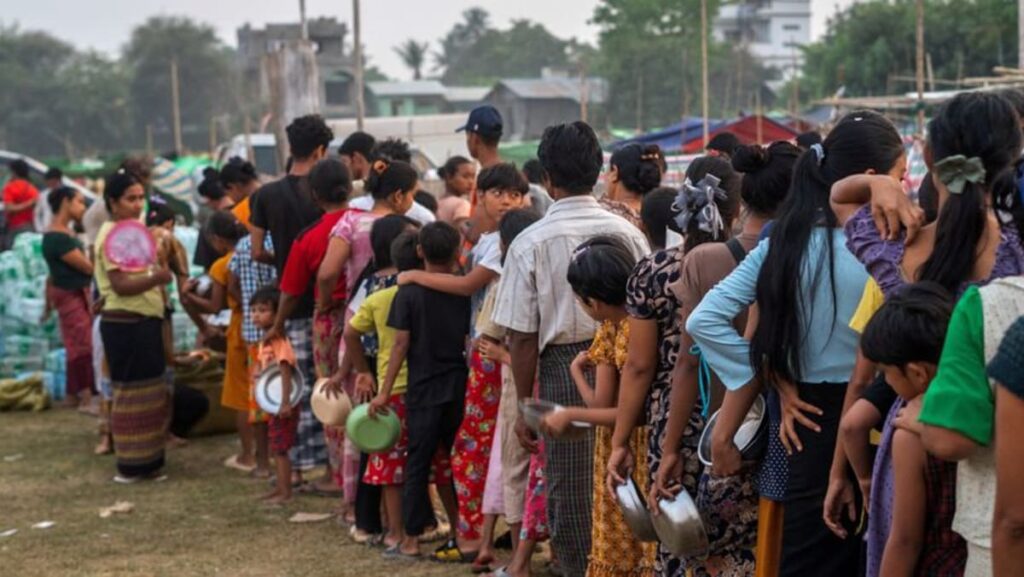Humanitarian agencies said access to sanitation and hygiene is becoming increasingly challenging, with clean water in short supply.
Mandalay resident Kathy Oo said: “It is a huge problem. I don’t know where I can shower. Even if I go to a friend’s place, there is no water or electricity.”
With monsoon rains expected to hit in weeks, the United Nations has warned of a risk of disease outbreaks such as cholera and malaria.
RESCUERS FACE CERTAIN DANGERS
The powerful quake also compounded an already-dire humanitarian crisis in a country where millions have been displaced by a bloody civil war since a military coup in 2021.
The Myanmar army said it fired warning shots when a Red Cross Society of China aid convoy failed to stop in a conflict zone on Tuesday.
The nine-vehicle convoy was carrying aid supplies to Mandalay, Myanmar’s second-largest city that was among the hardest-hit by the quake.
A junta spokesperson said the Chinese Red Cross team did not inform authorities of its presence in the area.
China said both the rescue team and its supplies are safe and urged all parties in Myanmar to protect aid workers and prioritise quake relief efforts.
Several rebel armed groups have suspended hostilities following the disaster to allow aid to reach affected areas.
Myanmar’s military on Wednesday announced a temporary ceasefire until Apr 22 to facilitate rehabilitation, according to state-run broadcaster MRTV.
The incident highlighted the dangers aid workers face and the difficulties in delivering humanitarian relief in Myanmar.
Still, aid agencies are pressing on with search-and-rescue operations despite fading hopes of finding any more survivors. They also face challenges as many roads and bridges are damaged and affected areas are still without power and telephone connections.
SINGAPORE’S AID RELIEF EFFORTS
One of the first foreign aid groups on the ground in Myanmar was Singaporean non-profit organisation Humanity Matters.
The team, which reached Myanmar a day after the quake, brought a water treatment system to supply safe drinking water to survivors and hospitals.
Along with partners from the ASEAN Civilian Alliance for Regional Emergencies (ASEAN Care), they are setting up temporary shelters for 600 families who lost their homes. Amenities in the shelters include toilets, living spaces and communal kitchens.
“The devastation is massive in terms of extent and scale. Many people have lost their dear ones, many more left homeless,” said the non-profit’s special adviser Hassan Ahmad.
“They are now living in the open in the midst of a heatwave with soaring temperatures of over 37 degrees Celsius. It is therefore crucial that they are protected from the trying weather elements and are appropriately hydrated to prevent any illnesses.”
Singapore’s Ministry of Defence said the Republic of Singapore Air Force has sent two C-130 planes with more than 9,000kg of relief supplies from ASEAN’s humanitarian assistance centre to Myanmar.
The Singapore Red Cross on Wednesday said it has deployed 90 water filters to Mandalay and Sagaing – the city nearest to the epicentre of the quake.
“Providing reliable solutions to clean water will ensure that affected communities have consistent access to safe drinking water and help to mitigate the risk of waterborne diseases,” said its secretary-general and CEO Benjamin William.
The charity has also received almost S$1.5 million (US$1.1 million) in donations for relief efforts in Myanmar and neighbouring Thailand, which has also been affected by the disaster.
The United Nations says 25 rescue teams from 13 countries are now on the ground in Myanmar.
The backbone of the relief efforts, however, is still the people of Myanmar, who are familiar with their streets and neighbourhoods and are helping in every way to hold their shattered communities together.
Read the full article here
